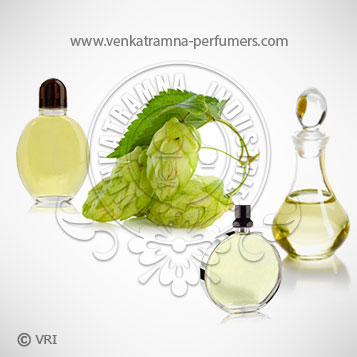
| Botanical Name | Humulus lupulus |
| Common Name | Cones |
| Country of Origin | Germany |
| Solubility | Soluble in alcohol, insoluble in water |
| Specific Gravity | 0.86820 - 0.89230 @ 25.00 °C |
| Optical Rotation | (-2)-(+2.5) |
| Refrective Index | 1.470 – 1.494 @ 20 C |
| PlantPart | Leaves and flowers |
| Bland With | It can mix easily with acetaldehyde di-(Z)-3-hexen-1-yl acetal, acetaldehyde ethyl phenethyl acetal |
| CAS No | 8007-04-3 |
| Flash Point | 118.00 °F |
| Extraction Method | Steam Distillation |
It has a warm, spicy aroma and flavor that makes it a major contributor to be used in the creation and/or manufacturing of flavor & fragrance agents. Further, it can also be used directly on the body as skin safe perfume oil. Other than this, it also finds usage in aromatherapy based applications.
In herbal medicine the use of hyssop has fallen out of fashion, though the ancients swore by it. Hyssop is a perennial herb of the mint family, though in northern climes it can be considered as an annual. In Tudor times it was fashionable to grow hyssop as a hedging plant for their knotted gardens. In those days it was much appreciated, as not just as medicine, but also for its fragrance and flavour. It became an important ingredient of Chartreuse and similar herbal liqueurs and is also one of the most important ingredients of 'Eau de Cologne'. But most famously, Hyssop is one of the most frequently mentioned herbs of the Bible, which extols its purifying virtues. However, opinions differ as to the true identity of the biblical Hyssop, as some believe it to be based on mistranslation of the word 'azob' (Greek) or 'azaf' (Arab), both of which simply mean 'Holy Herb'. Heated theological arguments prevail. Meanwhile, other myths spring forth, and it is said that Hyssop was the sacred Herb used to pass the vinegar soaked sponge to Christ at the crucifixion. Whatever the case may be, Hyssop is a powerful and valuable healing plant in its own right, whether or not it is indeed the biblical herb so revered by the ancients. However, epileptics should stay away from this oil and it should also be avoided during pregnancy.
Color : Golden Amber with a warm, spicy aroma,
Aroma : Hysoop oil has a warm and sweet smell.
It consists of asparagine, oline, humulene, inositol, lupulin, lupulinic acid, lupulon, manganese, valerianic acid, tannins, estrogenic substances, bitter principle, flavonoids, PABA, picric acids, resin, and vitamin B6.
Hops have long been used in the production of beers in Germany. It is also used for anodyne (relieves pain), anthelmintic, diuretic, febrifuge, hypnotic, nervine, sedative, soporific, tonic, anaphrodisiac and stomachic properties.